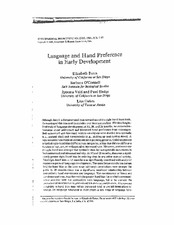| dc.creator | Bates, Elizabeth | |
| dc.creator | O'Connell, B. | |
| dc.creator | Vaid, Jyotsna | |
| dc.creator | Sledge, Paul | |
| dc.creator | Oakes, Lisa | |
| dc.date.accessioned | 2017-02-04T23:07:39Z | |
| dc.date.available | 2017-02-04T23:07:39Z | |
| dc.date.issued | 1986 | |
| dc.identifier.citation | Developmental Neuropsychology, 2(1), 1-15 | en |
| dc.identifier.uri | https://hdl.handle.net/1969.1/158722 | |
| dc.description.abstract | Although there is a demonstrated bias toward use of the right hand from birth, the meaning of this bias and its stability over time are unclear. Within a longitudinal study of language development at 13,20, and 28 months, we extracted information about unimanual and bimanual hand preference from videotapes. Both unimanual and bimanual actions on objects were divided into symbolic (e.g., pretend play) and nonsymbolic (e.g., picking up and putting down). A separate count was made of communicative pointing gestures. Children showed a marked right‐hand bias (70%) across categories, a bias that did not differ as a function of age, sex, or unimanual or bimanual type. However, preference for the right hand was stronger for symbolic than for nonsymbolic movements in both unimanual and bimanual activity. At 13 and 28 months, there was a significantly greater right‐hand bias in pointing than in any other manual activity. Total right‐hand bias at 13 months was significantly correlated with analytic/ receptive aspects of language development. The same linear correlation did not hold for hand bias at the later stage (although correlations were stronger for girls). At 20 months there was a significant nonlinear relationship between nonsymbolic hand movements and language. This combination of linear and curvilinear patterns, together with the greater hand bias for symbolic communicative activities that are compatible with language, led us to consider the contralateral interference hypothesis of Kinsbourne and Hiscock. A temporary instability in hand bias may reflect increased need to use left‐hemisphere resources for language whenever a child enters a new stage of language functioning. This would lead to “cyclic” patterns of hand preference around major milestones in language, particularly for nonsymbolic actions that compete with language. | en |
| dc.language.iso | en_US | |
| dc.publisher | Taylor and Francis Online | |
| dc.subject | gesture, hand preference, language development, developmental cognitive neuroscience | en |
| dc.title | Language and hand preference in early development | en |
| dc.type | Article | en |
| local.department | Psychology | en |
| dc.identifier.doi | http://www.tandfonline.com/doi/abs/10.1080/87565648609540323 | |


